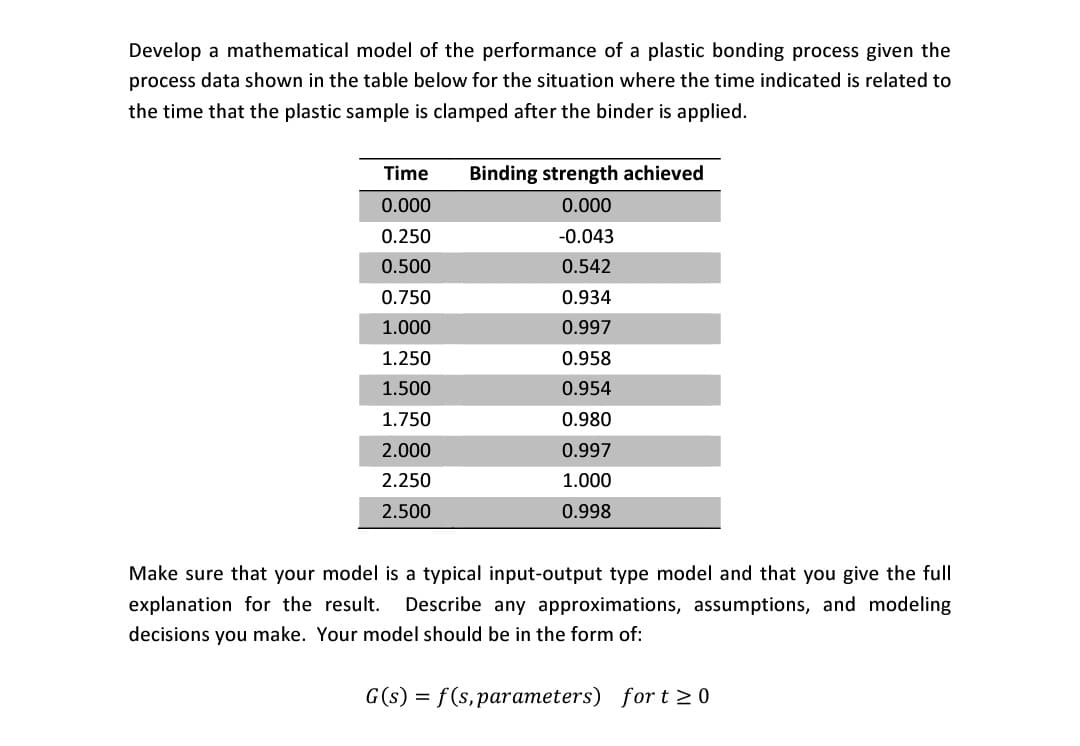Develop a mathematical model of the performance of a plastic bonding process given the process data shown in the table below for the situation where the time indicated is related to the time that the plastic sample is clamped after the binder is applied. Time 0.000 0.250 0.500 0.750 1.000 1.250 1.500 1.750 2.000 2.250 2.500 Binding strength achieved 0.000 -0.043 0.542 0.934 0.997 0.958 0.954 0.980 0.997 1.000 0.998 Make sure that your model is a typical input-output type model and that you give the full explanation for the result. Describe any approximations, assumptions, and modeling decisions you make. Your model should be in the form of: G(s) = f(s, parameters) fort≥0
Develop a mathematical model of the performance of a plastic bonding process given the process data shown in the table below for the situation where the time indicated is related to the time that the plastic sample is clamped after the binder is applied. Time 0.000 0.250 0.500 0.750 1.000 1.250 1.500 1.750 2.000 2.250 2.500 Binding strength achieved 0.000 -0.043 0.542 0.934 0.997 0.958 0.954 0.980 0.997 1.000 0.998 Make sure that your model is a typical input-output type model and that you give the full explanation for the result. Describe any approximations, assumptions, and modeling decisions you make. Your model should be in the form of: G(s) = f(s, parameters) fort≥0
Elements Of Electromagnetics
7th Edition
ISBN:9780190698614
Author:Sadiku, Matthew N. O.
Publisher:Sadiku, Matthew N. O.
ChapterMA: Math Assessment
Section: Chapter Questions
Problem 1.1MA
Related questions
Question
Good morning. Kindly help me with this homework as soon as possible and show step by step how you worked it out.

Transcribed Image Text:Develop a mathematical model of the performance of a plastic bonding process given the
process data shown in the table below for the situation where the time indicated is related to
the time that the plastic sample is clamped after the binder is applied.
Time
0.000
0.250
0.500
0.750
1.000
1.250
1.500
1.750
2.000
2.250
2.500
Binding strength achieved
0.000
-0.043
0.542
0.934
0.997
0.958
0.954
0.980
0.997
1.000
0.998
Make sure that your model is a typical input-output type model and that you give the full
explanation for the result. Describe any approximations, assumptions, and modeling
decisions you make. Your model should be in the form of:
G(s) = f(s, parameters) for t≥0
Expert Solution
This question has been solved!
Explore an expertly crafted, step-by-step solution for a thorough understanding of key concepts.
Step by step
Solved in 5 steps with 10 images

Knowledge Booster
Learn more about
Need a deep-dive on the concept behind this application? Look no further. Learn more about this topic, mechanical-engineering and related others by exploring similar questions and additional content below.Recommended textbooks for you

Elements Of Electromagnetics
Mechanical Engineering
ISBN:
9780190698614
Author:
Sadiku, Matthew N. O.
Publisher:
Oxford University Press

Mechanics of Materials (10th Edition)
Mechanical Engineering
ISBN:
9780134319650
Author:
Russell C. Hibbeler
Publisher:
PEARSON

Thermodynamics: An Engineering Approach
Mechanical Engineering
ISBN:
9781259822674
Author:
Yunus A. Cengel Dr., Michael A. Boles
Publisher:
McGraw-Hill Education

Elements Of Electromagnetics
Mechanical Engineering
ISBN:
9780190698614
Author:
Sadiku, Matthew N. O.
Publisher:
Oxford University Press

Mechanics of Materials (10th Edition)
Mechanical Engineering
ISBN:
9780134319650
Author:
Russell C. Hibbeler
Publisher:
PEARSON

Thermodynamics: An Engineering Approach
Mechanical Engineering
ISBN:
9781259822674
Author:
Yunus A. Cengel Dr., Michael A. Boles
Publisher:
McGraw-Hill Education

Control Systems Engineering
Mechanical Engineering
ISBN:
9781118170519
Author:
Norman S. Nise
Publisher:
WILEY

Mechanics of Materials (MindTap Course List)
Mechanical Engineering
ISBN:
9781337093347
Author:
Barry J. Goodno, James M. Gere
Publisher:
Cengage Learning

Engineering Mechanics: Statics
Mechanical Engineering
ISBN:
9781118807330
Author:
James L. Meriam, L. G. Kraige, J. N. Bolton
Publisher:
WILEY